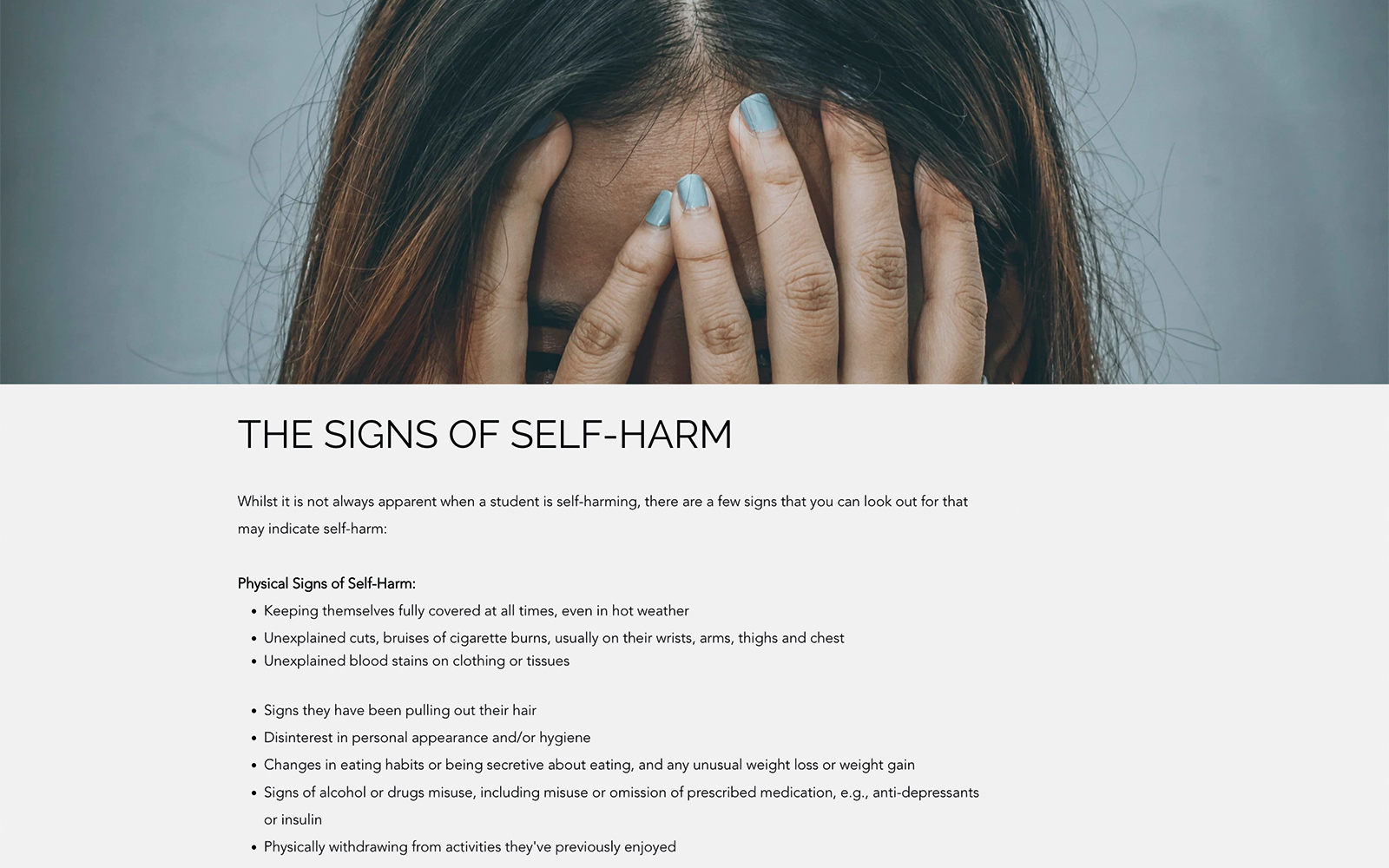Emmie Hopkinson and Zoe Clark discuss how a self-harm educational website for teachers can positively impact children and young people.

Between one in five and one in seven adolescents in England self-harm (Uh et al, 2021). But there is no governmental health campaign focusing on the prevention and treatment of self-harm in adolescents; this is alarming, considering that in 15- to 17-year-olds, for example, for every male suicide, 120 males present to hospital with self-harm, whereas for every female suicide, 919 females present to hospital for self-harm (Geulayov et al, 2018). This article will examine the influences behind self-harm in adolescents and its increasing rate, the opportunities and challenges that are associated with self-harm and the realistic solutions and health promotion resources that can be implemented to prevent and manage self-harm within the community.
In an average size class of 22.6 students (Department for Education, 2022a), there are potentially four students who self-harm. Nationally, this further suggests that out of three million secondary school students, there could be approximately 900,000 students who are, at present, self-harming, which can lead to long-term consequences: those who continue to engage in self-harm during adolescence are reported to have a significant increase in anxiety, depression and negative health outcomes as adults (Daukantaitė et al, 2020).
In addition, there is a correlation between using self-harm to cope with emotional behaviours and an increased risk of suicide (McManus et al, 2019). Therefore, the evidence suggests that early intervention in adolescence is imperative to prevent increased negative mental and physical health outcomes and the risk of suicide.

Challenges and opportunities
An apparent challenge in addressing self-harm is the lack of standardised framework in the personal, social, health and economic (PSHE) national curriculum (Department for Education, 2021). One study (Davies and Matley, 2019) concluded that teachers felt they received insufficient access to training in PSHE, and the confidence to teach the topic of mental health was lower than for other topics. A potential solution to this challenge could be for teachers to receive PSHE education from school nurses. This is because school nurses are more knowledgeable in PSHE topics such as mental health and have access to clear, evidence-based information. The school nurse can then implement this information into training programmes for teachers, giving them the information they need to teach their students effectively and confidently (Price, 2020).
Students subjected to self-harm content online are more likely to self-harm themselves because they are interacting and learning this behaviour from the content
Another challenge is the lack of appropriate self-harm education for nurses. In their study of emergency department nurses, Rayner et al (2018) identified limited empathy towards patients who self-harmed and recommended education and knowledge for emergency department nurses around this issue. Creating an e-learning module on self-harm that educates nurses on this topic would provide an opportunity for nurses to have a more developed understanding of self-harming patients (Rouleau et al, 2019).
Safeguarding
In accordance with the ‘Keeping Children Safe in Education’ policy (Department for Education, 2022b), school staff are required to recei

ve safeguarding training at their induction and receive further updated training regularly. It can be inferred that, due to lack of clarity around the word ‘regularly’, schools will only update their safeguarding training according to their perception of the word ‘regular’, which could mean every few weeks, months or years.
Moreover, this policy recommends that emails and e-bulletins are used to convey updated information. While this can be effective, it is important to have regular face-to-face sessions so that teachers continue to develop theoretical and practical knowledge within their teaching practice (Torok et al, 2019). An excellent safeguarding against self-harm resource is the sample self-harm policy created by Norfolk County Council and the NHS (2020). This policy demonstrates the importance of teachers being knowledgeable and non-judgemental in their approach to identifying students who self-harm, and it advises the teacher on steps they should take to best intervene and support the student.
For example, there is clear structure on how the teacher should respond when a young person is self-harming, some conversation phrases that can aid the teacher when discussing self-harm with the young person, and guidance on how the school can prevent self-harm by taking steps such as blocking websites that promote self-harm.
Health promotion
One health promotion model that can be utilised in relation to self-harm is social cognitive theory (Bandura, 1986). This posits that behavioural learning occurs within the social context of the individual’s interactions, behaviours and environment. For example, students subjected to self-harm content online are more likely to self-harm themselves because they are interacting and learning this behaviour from the content they are viewing and from the internet users that they are interacting with (Marchant et al, 2017). However, Bandura’s theory used within a health promotion resource can be positively influential in intervening and preventing adolescents from self-harming. For example, by creating a website aimed specifically at educating teachers on self-harm, these teachers then have the confidence and the knowledge to have open discussions with their students on self-harm (interaction), implement positive coping mechanisms (behaviour) that the students can use and potentially intervene in self-harm behaviours earlier by creating a safe space (environment) in which students can discuss their feelings (Dowling and Doyle, 2017).
Montagni et al (2016) found that the internet was a useful tool for finding specific health information. This demonstrates that a website could potentially be a practical and accessible form of health promotion resource for teachers to obtain, use and distribute to other school staff.

Conclusion
In conclusion, self-harm in adolescence is a growing public health issue that needs to be addressed. A website is an easy-to-use, accessible and evidence-based resource that can assist teachers in understanding self-harm and encouraging them to become more knowledgeable and confident in discussing self-harm openly with their students, which can lead to prevention and intervention in self-harm behaviour.
Likewise, an accessible website would also be beneficial to increase awareness and knowledge for school nurses, as well as be a relevant tool for children and young people themselves to utilise for educational and informational purposes.
Emmie Hopkinson is a third- year student nurse at Kingston University; Zoe Clark is associate professor for quality at Kingston University.
*Website screenshots are from a prototype website created by Emmie Hopkinson.
References
Bandura, A. (1986) Social foundations of thought and action: a social cognitive theory. Prentice Hall: New Jersey. See: sciencedirect.com/topics/social-sciences/social-cognitive-theory (Accessed 16 February 2023).
Daukantaitė D, Lundh LG, Wångby-Lundh M et al. (2020) What happens to young adults who have engaged in self-harm injurious behaviour as adolescents? A 10-year follow-up. European Child & Adolescent Psychiatry 30(2): 475-92.
Davies EL, Matley F. (2019) Teachers and pupils under pressure: UK teachers’ views on the content and format of personal, social, health, and economic education. Pastoral Care in Education 38(1): 4-22.
Department for Education. (2022a) Schools, pupils and their characteristics. See: https://explore-education-statistics.service.gov.uk/find-statistics/school-pupils-and-their-characteristics (accessed 13 February 2023).
Department for Education. (2022b) Keeping children safe in education 2022: statutory guidance for schools and colleges. See: https://assets.publishing.service.gov.uk/government/uploads/system/uploads/attachment_data/file/1101454/Keeping_children_safe_in_education_2022.pdf (accessed 14 February 2023).
Department for Education. (2021) Personal, social, health and economic (PSHE) education. See: gov.uk/government/publications/personal-social-health-and-economic-education-pshe/personal-social-health-and-economic-pshe-education (accessed 13 February 2023).
Dowling S, Doyle L. (2017) Responding to self-harm in the school setting: the experiences of guidance counsellors and teachers in Ireland. British Journal of Guidance and Counselling 45(5): 583-92.
Geulayov G, Casey D, McDonald KC et al. (2018) Incidence of suicide, hospital-presenting non-fatal self-harm, and community-occurring non-fatal self-harm in adolescents in England (the iceberg model of self-harm): a retrospective study. The Lancet Psychiatry 5(2): 167-74.
Marchant A, Hawton K, Stewart A et al. (2017) A systematic review of the relationship between internet use, self-harm and suicidal behaviour in young people: The good, the bad and the unknown. PLOS ONE 12(8): e0181722.
McManus S, Gunnell, D, Cooper C et al. (2019) Prevalence of non-suicidal self-harm and service contact in England, 2000-14: repeated cross-sectional surveys of the general population. The Lancet Psychiatry 6(7): 573-81.
Montagni I, Donisi V, Tedeschi F et al. (2016) Internet use for mental health information and support among European university students: The e-MentH project. Digital Health 2: 2055207616653845.
Norfolk County Council, NHS. (2020) Self-harm policy. See: www.schools.norfolk.gov.uk/-/media/schools/files/school-management/critical-incidents/self-harm-policy.pdf (accessed 14 February 2023).
Price C. (2020) Self-harm in schools: does an eLearning training module improve UK secondary school teachers’ knowledge and confidence in supporting young people who self-harm?. University of Surrey. See: https://openresearch.surrey.ac.uk/esploro/outputs/doctoral/Self-harm-in-schools–does-an-elearning-training-module-improve-UK-secondary-school-teachers-knowledge-and-confidence-in-supporting-young-people-who-self-harm/99513289002346 (Accessed 13 February 2023).
Rayner G, Blackburn J, Edward KL et al. (2018) Emergency department nurse’s attitudes towards patients who self-harm: A meta-analysis. International Journal of Mental Health Nursing 28(1): 40-53.
Rouleau G, Gagnon MP, Côte J et al. (2019) Effects of e-learning in a continuing education context on nursing care: systematic review of systematic qualititaive, quantitive, and mixed-studies reviews. Journal of Medical Internet Research 21(10): e15118.
Torok M, Calear AL, Smart A et al. (2019) Preventing adolescent suicide: a systematic review of the effectiveness and change mechanisms of suicide prevention gatekeeping training programs for teachers and parents. Journal of Adolescence 73: 100-12.
Uh S, Dalmaijer ES, Siugzdaite R et al. (2021) Two pathways to self-harm in adolescence. Journal of the American Academy of Child & Adolescent Psychiatry 60(12): 1491-500.
Image credit | Shutterstock





